WASHINGTON - Whether you love them, hate them, or are in the process of building them, electric vertical takeoff and landing (eVTOL) air taxis have a key hurdle to overcome: noise. Air taxi manufacturers are turning to NASA for assistance, Jack Daleo writes for Flying. Continue reading original article.
The Military & Aerospace Electronics take:
16 April 2024 - Several air taxi companies are leveraging a computer software tool developed by NASA to forecast aircraft noise and aerodynamic performance. This tool enables manufacturers involved in NASA’s Advanced Air Mobility mission to assess the performance of design elements such as propellers or wings early in the aircraft development process. Consequently, this facilitates significant time and cost savings for the industry by streamlining potential design modifications.
Named "OVERFLOW," this NASA computer code conducts calculations to anticipate fluid flows like air, as well as the resulting pressures, forces, moments, and power requirements exerted on the aircraft. Given that these fluid flows contribute to aircraft noise, enhanced predictions aid engineers in crafting quieter models. Manufacturers have the capability to integrate the code with their own aircraft modeling programs, enabling them to run various scenarios, quantify performance and efficiency, and visually analyze how airflow interacts with and envelops the vehicle.
Related: AFWERX, NASA collaborate to develop digital Advanced Air Mobility operations center
Related: U.S. Air Force to share data with FAA on advanced air mobility testing
Related: Airbus, LCI collaborate to develop advanced air mobility ecosystems
Jamie Whitney, Senior Editor
Military + Aerospace Electronics

